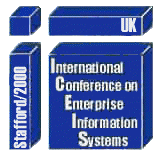 ICEIS 2000
ICEIS 2000
Ronald Stamper
Emeritus Professor of Information Management, University of Twente in the Netherlands
Information Requirements are Human, Computers only Machines: MEASUR’s Rigorous Methods Based on Social Norms
Abstract
Surely we need a revolution! By far the greater part of IS costs are non-technical and most IS failures stem from poor understanding of organisational requirements and preparation for change. After a revolution through 180 degrees we might stand facing the organisation and realise that the computer can do no more than efficiently manipulate meaningless syntactic structures. The most efficient circulation and processing of information are valueless unless it conveys meanings and express intentions that can influence the responsible people.
MEASUR uses these italicised concepts to find the human information requirements in a precise form, and even deliver a default version of the technical system. First, Problem Articulation Methods support teams of users to devise solutions, prepare the organisational changes and plan the project. The computer will fit into a part of the system, which is then subjected to detailed Semantic Analysis. From the resulting Semantic Normal Form (SNF) a default implementation can be generated.
The practical benefits of MEASUR are many. Users can understand, criticise and improve the specifications that are 20th of the normal volume. This reduces the risk of not meeting organisational needs – the reason why 60% of systems fail. Development, support and maintenance costs are slashed by a factor of ten. The components of the design are reusable and the system can be implemented by a Just-in-Time strategy because of the stability of the specification. The design of the organisation has no technical elements so it provides an ideal basis for an outsourcing contract. The methods can even be applied to drafting the contract because they are based on an understanding of social and legal norms.
Underlying MEASUR is the idea of Information Fields. Each of these is group of people operating according to the same norms. An organisation consists of many overlapping Information Fields. The norms govern the information requirements: the meanings, intentions, responsibilities and influence exerted. By comparison, the technical matters are mere details, although we spend all our time on them.
The lecture will illustrate the methods.